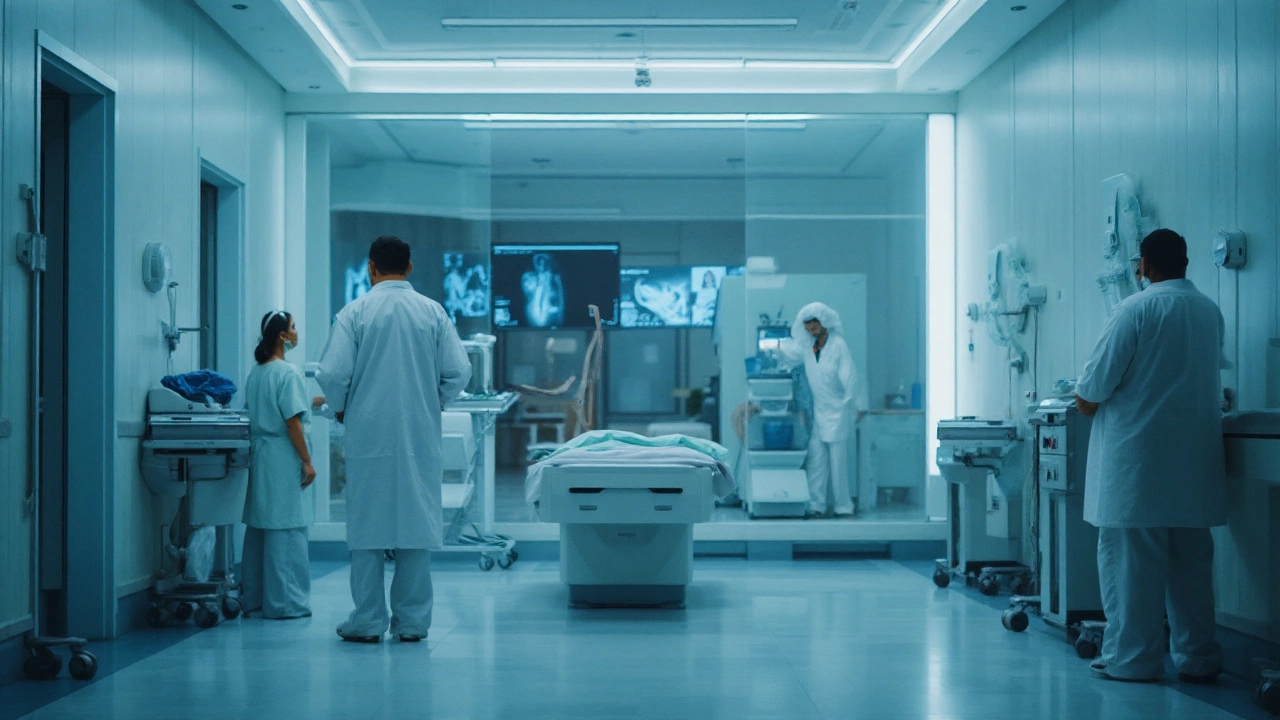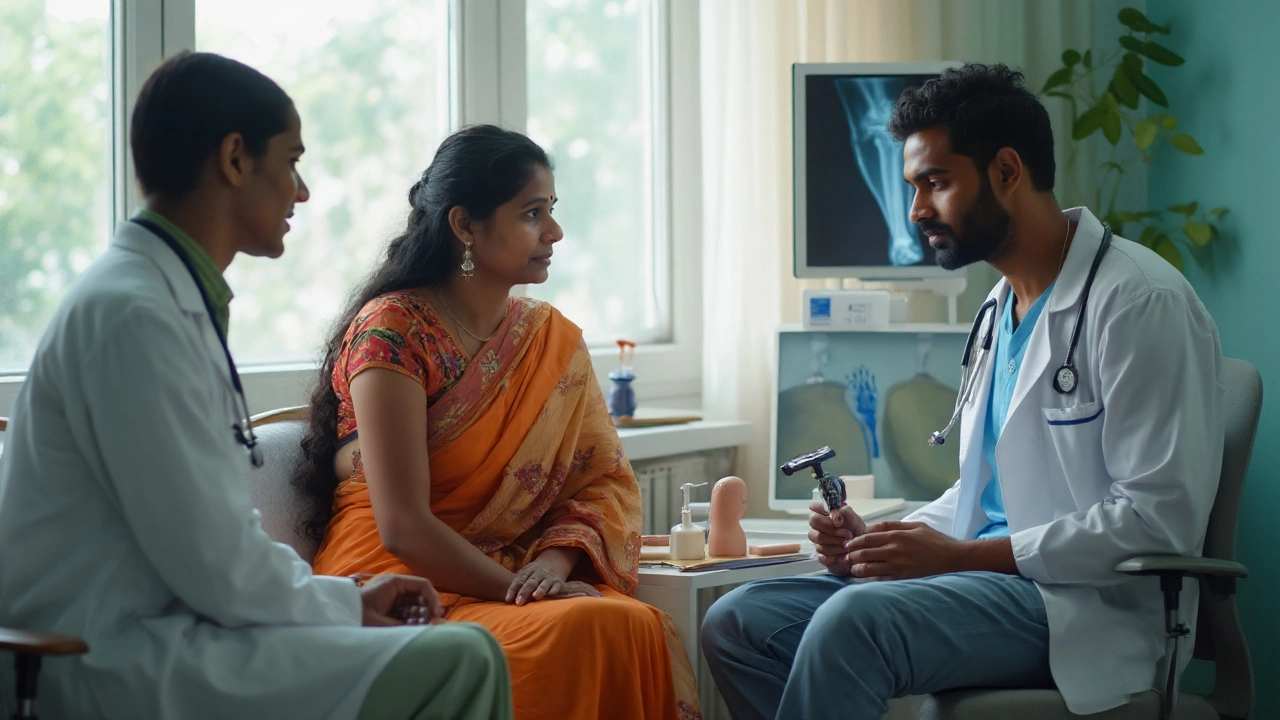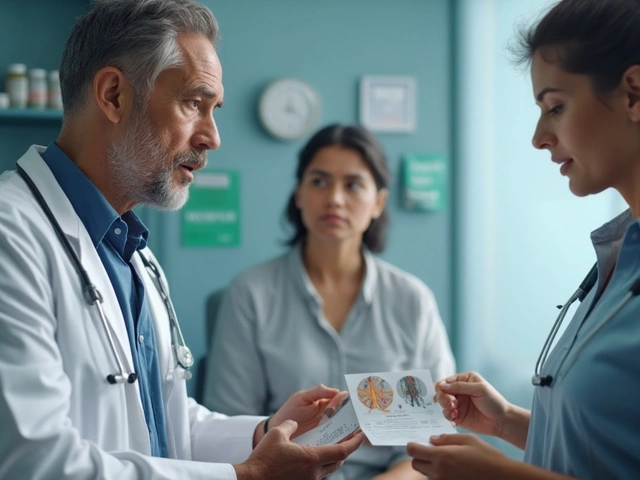If you’ve booked your first appointment with an orthopedic surgeon, you probably want clarity: what exactly happens in that room, will you need scans right away, and will you walk out with relief or just more tests? I’m writing this from Pune, where clinic days run fast and questions often go unasked. Here’s the clean, no-drama version of what to expect, how to prepare, and how to get the most out of that precious 15-30 minutes.
TL;DR
- You’ll get a focused history, a movement/strength exam, and-if indicated-basic imaging like X-rays. Many soft-tissue injuries don’t need an MRI on day one.
- Come ready with a concise symptom timeline, past reports, meds, and a list of your top three questions. Wear clothing that lets you move.
- Expect a first-cut plan: pain control, activity tweaks, physiotherapy, sometimes braces or an injection; surgery is rarely decided on day one unless it’s urgent.
- In India, typical 2025 ballparks: X-ray ₹300-800, MRI ₹4,000-9,000 (region-dependent), physio ₹500-800/session; varies by city and facility.
- Red flags (fever with joint pain, numbness/weakness, night pain, trauma) may fast-track scans or urgent treatment.
What you probably want to achieve after clicking this page:
- Know the exact steps of the first visit, so nothing surprises you.
- Prepare the right info and clothes, so the exam is accurate and efficient.
- Understand when X-ray vs MRI is needed-and when it’s not.
- Walk out with a clear plan: meds, physio, braces, injections, or surgery timelines.
- Estimate time and costs in the Indian context, including insurance basics.
What Actually Happens During Your First Orthopedic Visit
The first visit is about two things: correct diagnosis and a practical plan. Orthopedic surgeons do this by listening, looking, and-only if needed-imaging. The American Academy of Orthopaedic Surgeons (AAOS) and the Indian Orthopaedic Association emphasize that a careful history and physical exam often point to the right diagnosis before any scan is ordered.
Step-by-step flow you can expect:
- Check-in and paperwork: You’ll note your pain areas, past surgeries, allergies, current medicines, and insurance details. If you’ve got old reports, hand them over now.
- Focused history (3-8 minutes): Expect specific questions: When did this start? Any injury or repetitive activity? What makes it better/worse? Morning stiffness or night pain? Numbness or weakness? Fever, weight loss, or other systemic symptoms? If it’s a knee or shoulder, expect sport/work questions and exact motions that hurt.
- Physical exam (5-12 minutes): This is hands-on. You’ll be asked to move-bend, squat, raise your arm, twist your back. The doctor checks range of motion, strength, joint stability (special tests like Lachman for ACL, Hawkins for shoulder impingement), alignment, swelling, warmth, and tender spots. For spine issues, they’ll check reflexes and sensation. Good exams are gentle but thorough; speak up if something sharply hurts.
- Point-of-care decisions: Based on what the doc hears and sees, they’ll decide if you need imaging today. Clear deformity or suspected fracture? X-ray now. Suspected ligament tear in a young athlete? Maybe MRI soon. Typical mechanical back pain with no red flags? Usually no scan on day one.
- Explanation and plan: You should hear the likely diagnosis in plain English, what’s happening anatomically, and the first-line plan-meds, activity modification, physio, optional braces/taping, and when to reassess. If an injection or urgent procedure is needed, you’ll hear why.
- Documentation: You’ll leave with a prescription, physio referral, any imaging requisitions, and follow-up instructions. If you need a work/sports note, ask now.
That’s the typical arc of an orthopedic surgeon first visit. It’s focused, practical, and quicker than you think. When I took my father to an ortho in Pune last monsoon for a swollen knee, that exact flow helped us avoid an unnecessary MRI and move straight to targeted physio, which solved most of it.
How to Prepare: What to Bring, What to Wear, What to Say
Good prep saves time, money, and guesswork. It also reduces the chance you’ll be sent for tests you don’t need.
What to bring:
- Photo ID, insurance/TPA card (if you have cashless plans), referral if required.
- All prior imaging and reports (X-rays, MRI, CT, ultrasound), plus lab tests. Bring films or a CD if available; prints alone can miss details.
- Medication list (names, doses), including OTC pain relievers and supplements.
- Shoes or braces you use for the problem-orthotics, knee sleeves, wrist splints.
- List of top 3 questions. Example: “Is this a tendon issue or arthritis?”, “Can I keep running?”, “What’s the fastest safe way back to work?”
What to wear:
- Knee/hip/ankle/foot: shorts or loose track pants.
- Shoulder/elbow/wrist: sleeveless top or loose T-shirt.
- Spine: T-shirt and comfortable trousers you can bend in.
What to say (be specific):
- Onset and trigger: “Started 3 weeks ago after a fall from a bike,” or “Gradual start after increasing tennis to 5 days/week.”
- Pain pattern: sharp vs dull, constant vs activity-based, night pain, morning stiffness.
- Function impact: “Can’t climb stairs,” “Can’t sit beyond 30 minutes,” “Grip is weak.”
- Self-care tried: rest, ice/heat, OTC meds, braces, home exercises-and whether they helped.
Two small but powerful tips:
- Arrive 10 minutes early. Rushing spikes your pain and heart rate, and you forget details.
- Bring one companion if you tend to forget instructions. A second pair of ears helps.
Scans and Tests: When You Need X-rays, MRIs, or Blood Work (and What They Cost in India)
Orthopedics uses imaging to confirm-not to guess. Evidence-based guidance (AAOS, NICE NG59 updated through 2024, and Choosing Wisely recommendations) is clear: avoid routine imaging when history and exam don’t point to a serious issue.
Quick rule-of-thumb:
- Suspected fracture, dislocation, advanced arthritis, or alignment issue: X-ray first.
- Suspected tendon/ligament tear or cartilage damage, and it affects function a lot: MRI, usually after initial swelling settles-unless it changes urgent management.
- Swollen, warm, very painful joint with fever or recent infection: urgent labs +/- joint aspiration (to rule out infection or gout).
- Typical low back pain without red flags: no imaging in the first 4-6 weeks.
Red flags that change the plan immediately:
- Severe trauma, deformity, or inability to bear weight.
- Fever, chills, or redness with joint pain; recent skin or urinary infection.
- Night pain that’s worsening, unintended weight loss, history of cancer.
- New numbness, weakness, or bowel/bladder changes (spine emergency).
Common tests, what they show, and typical 2025 India ballparks (varies by city and facility):
- X-ray: Bones, alignment, joint space, fractures. Cost: ~₹300-₹800 per view in many cities. Fast, low radiation.
- MRI: Ligaments, tendons, cartilage, discs, marrow. Cost: ~₹4,000-₹9,000 (joint/spine region dependent). No radiation; can take 20-45 minutes.
- Ultrasound (MSK): Rotator cuff, tendons, fluid. Cost: ~₹1,200-₹2,500. Operator-dependent but handy, painless, real-time.
- CT: Complex fractures, pre-op planning. Cost: ~₹2,500-₹6,000 for focused areas. More radiation than X-ray.
- Labs: CBC, CRP/ESR (inflammation), uric acid (gout), HLA-B27 (inflammatory back pain), vitamin D, calcium. Cost: basic panels ~₹600-₹2,000.
Safety notes:
- Pregnancy: Avoid X-rays unless absolutely necessary; if needed, shielding is used.
- MRI and implants: Tell the clinic if you have pacemakers or certain metal implants. They’ll screen you.
- Claustrophobia: Ask for an open MRI or mild sedation if needed; tell your doctor beforehand.
Insurance basics in India:
- Outpatient consults and scans are often not fully covered in basic policies. Some premium plans cover OPD up to a limit.
- For cashless MRI, you may need a referral and pre-authorization; check with your TPA.
- Keep all receipts and prescriptions for reimbursement claims.
Why many MRIs can wait: In conditions like shoulder impingement, patellofemoral knee pain, or uncomplicated low back pain, good physio and activity tweaks can improve symptoms in 2-6 weeks. If things don’t improve or new red flags show up, MRI becomes far more useful-and more likely to change management.

Treatment on Day One: Pain Relief, Bracing, Physio, Injections, and Surgery Decisions
You won’t be left in limbo. Most people walk out with a plan that starts the same day. Here’s what that plan often includes, based on your diagnosis and goals.
Medications:
- Pain/anti-inflammatory: Short courses of NSAIDs or acetaminophen for pain. If you have acidity, kidney issues, or are on blood thinners, tell your doctor-choices change.
- Topicals: Gels can help for tendinopathies and mild joint pain with fewer systemic side effects.
- Nerve-related pain: For sciatica or nerve irritation, specific agents may be used short term.
- Bone/joint support: Vitamin D, calcium only if low or if fracture risk is high-your doc may order tests rather than guessing.
Activity and load management:
- Relative rest, not bed rest. Keep moving within pain limits; avoid the exact motions that flare the problem.
- Workarounds: Example-swap running for cycling while a knee calms down; change your desk ergonomics for back/neck issues.
- Return-to-play timelines are individualized. A light-grade ankle sprain may see jogging by week 2-3; a meniscus tear being treated non-surgically may need 4-6 weeks.
Physiotherapy (often the star of the show):
- Your doctor may prescribe a phased plan: pain control, mobility, strength, and return-to-function.
- In India, one-on-one physio sessions typically cost ₹500-₹800 in many urban centers. Home exercises are the real driver of progress-ask for a clear sheet or app-based program.
- Red flags for physio referral timing: If a joint is hot/red, or there’s suspected fracture, you’ll treat that first before strengthening.
Braces and supports:
- Knee sleeves for patellofemoral pain, functional ankle braces for sprains, wrist splints for carpal tunnel, lumbar belts short term for acute back pain.
- Use braces as a bridge, not a crutch. Overreliance can decondition muscles.
Injections (when and why):
- Corticosteroid injections can calm stubborn inflammation in shoulder impingement, tennis elbow, or knee osteoarthritis. Useful for pain to enable rehab, but not a cure.
- Hyaluronic acid (for knee OA) and platelet-rich plasma (PRP) are options in select cases; evidence is mixed and cost varies widely. Ask about expected benefit duration.
- Typical India costs (very variable): steroid injections ₹1,500-₹6,000; HA ₹5,000-₹18,000; PRP ₹6,000-₹20,000 based on kit and facility.
Surgery: Rarely a day-one decision unless urgent (open fracture, locked knee, cauda equina-like symptoms, septic joint). For planned surgeries-ACL recon, rotator cuff repair, meniscus repair, joint replacement-you’ll usually do imaging, try conservative care if reasonable, and then decide with full counseling. Second opinions are welcome.
Clear markers of a good day-one plan:
- You understand the working diagnosis and what signs would change it.
- You know exactly what to do this week (meds, movements to avoid, exercises to start).
- You have a follow-up timeline and criteria for earlier review.
- Your financial next steps are transparent (tests, physio, aids).
Your Roadmap After the Visit: Timelines, Checklists, and a Self-Advocacy Toolkit
Recovery is a process. Here’s a practical roadmap by common scenarios, plus checklists you can use.
If you have acute low back pain without red flags:
- Week 0-1: Pain control, gentle mobility, walking, avoid bed rest. No imaging yet (consistent with NICE and Choosing Wisely).
- Week 2-4: Add core and glute strengthening; adjust work setup.
- Week 4-6: If not improving or if new neuro symptoms appear, talk MRI.
If you have a knee sprain (no fracture on X-ray):
- Week 0-1: RICE principles (protected rest, ice, compression, elevation), short-term brace, quad sets, pain-free range of motion.
- Week 2-3: Balance and strength work; light cycling.
- Week 3-6: Jogging and sport drills if pain-free and stable; consider MRI only if instability or persistent locking/catching.
If you have rotator cuff-type shoulder pain:
- Weeks 0-2: Anti-inflammatories (if safe), postural fixes, scapular activation, avoid painful overhead loading.
- Weeks 2-6: Progressive strengthening; consider guided injection if pain blocks rehab.
- Beyond 6 weeks: MRI if weakness persists or activity demands are high (heavy labor/athlete).
If you have osteoarthritis (knee/hip):
- Daily: Strengthen quads/hips, weight management if applicable, joint-friendly cardio (cycle, swim).
- Adjuncts: Heat for stiffness, braces/shoe inserts for alignment issues.
- Escalate: Injection for flares, discuss surgery only when pain/function stay unacceptable despite good rehab.
Bring-this checklist for the next visit:
- Daily pain/function log (short notes: pain score, activities, meds used).
- Proof you did the homework: completed exercise sheet or app history.
- Any side effects from meds or braces (rash, stomach upset, numbness).
- Questions you noted during the month.
Self-advocacy toolkit (use these lines verbatim if needed):
- “If we avoid MRI today, what specific signs should make me get it later?”
- “What one exercise gives me the biggest bang for my knee right now?”
- “If this plan doesn’t help in 4 weeks, what’s Plan B?”
- “Is there a lower-cost equivalent of this brace/scan nearby?”
FAQs, Costs, and Next Steps
How long does the first appointment take?
Typical consults run 15-30 minutes. If you need an X-ray and can get it in-house, add 20-30 minutes.
Will I get pain relief on day one?
Usually yes-via meds, taping, a brace, ice/heat advice, and a starter exercise plan. In select cases, an injection is offered.
Do I always need an MRI?
No. Many problems improve with targeted rehab and activity changes. MRI is most useful when the result will change what you do next.
Is it okay to exercise with pain?
Mild discomfort during rehab is okay; sharp pain that lingers after exercise is not. Use the “24-hour rule”: if you flare for more than a day, dial it back.
What if my pain is worse at night?
Night pain can simply mean inflammation, but persistent or worsening night pain deserves attention-especially if there’s weight loss, fever, or a history of cancer. Flag it early.
How do I choose between clinics?
Look for clear explanations, evidence-based decisions (no reflex MRIs), collaboration with good physios, and transparent costs. Word-of-mouth from people with similar problems helps.
Can I bring old reports from another city?
Yes, and you should. Imaging from the last 6-12 months can still be valuable, especially for chronic issues.
Rough cost snapshot in India (2025):
- Consultation: ₹600-₹1,500 depending on location and seniority.
- X-ray: ₹300-₹800 per view.
- MRI (single joint/spine region): ₹4,000-₹9,000.
- Physiotherapy session: ₹500-₹800 (one-on-one). Package discounts exist.
- Common braces: ₹700-₹3,000 depending on type/brand.
Next steps by persona:
- Desk worker with neck/back pain: Fix chair height and screen level today, start walking breaks every 45 minutes, learn two core exercises from a physio.
- Weekend athlete with ankle/knee sprain: Protect with a functional brace, begin range and balance work early, return to running when hop test is pain-free and stable.
- Senior with knee OA: Prioritize quad and hip strengthening, short frequent walks, consider a cane on the opposite side, discuss injection options for flares.
- Parent with a child’s sports injury: Push for a clear plan, not just rest. Kids heal fast but need guidance to avoid repeat injury.
When to seek urgent care instead of routine follow-up:
- New or worsening numbness/weakness in a limb, or bowel/bladder changes.
- High fever with a hot, swollen joint.
- Post-injury deformity or inability to bear any weight.
- Uncontrolled pain despite prescribed meds.
Behind the curtain-what guides doctors: Apart from training and experience, orthopedic decisions lean on standards from AAOS, the Indian Orthopaedic Association, and NICE. Those bodies consistently advise starting with a good history and exam, reserving imaging for when it changes management, and using rehab to restore function. That’s why your first visit feels very hands-on and very practical.
I’ve sat on both sides of the table-as a relative and as a patient. The consult that feels best is the one where you walk out knowing what to do tonight, what to watch for this week, and when to check back. If you get that, you had a great first visit.





